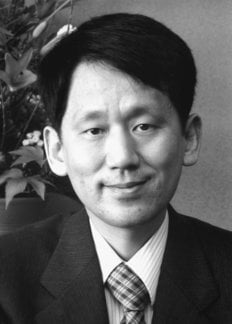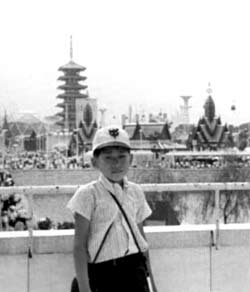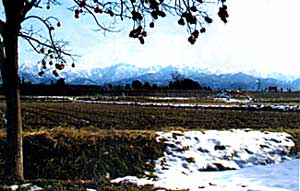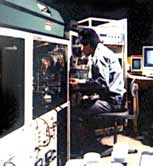Koichi Tanaka
Biographical

I was born in Japan on August 3, 1959. My natural mother died one month after I was born, apparently due to giving birth at an advanced age. Because my father was also physically frail, I was brought up by my uncle and aunt. When I use the words “father” and “mother” now, I am referring to the father and mother who raised me. Perhaps it was because of my easygoing character that I remained ignorant of my early circumstances until I was 18 years old, when my parents informed me of these circumstances. More likely, however, my blissful ignorance was due to the completely fair-minded upbringing I received by my parents, older sister and brothers, relatives and neighbours.
My parents operated a business selling and repairing carpentry tools in Toyama Prefecture. I grew up with images of my father sharpening saw-blade teeth and planes, images in which he was seemingly always busy working quietly with his hands. My mother was not only busy performing housework, but also making end-of-month collections and keeping the books of the family business until late at night. I have no memory of my parents encouraging me with words like ‘study’ or ‘succeed.’ There is no doubt, however, that the values they instilled in me were much more important than those suggested by these words. From my father, I learned the importance of working sincerely at things to which I had committed myself, and to persevere untiringly even in the face of little progress. My mother also stressed the importance of working quietly towards achieving my missions in life, without neglecting attention to details. My father passed away three years ago (1999).
Apart from my parents, I was also influenced by my grandmother. She often admonished me, using the expression “What a waste!” (“Mottai-nai!” in Japanese). While these words are approaching extinction these days, they used to be an integral part of the cultural values in Japan. My grandmother valued even the smallest of things. Once, when she noticed me crumpling up a sheet of paper to throw it away, she angrily reproached me, saying “What a waste. You could straighten that paper out and use it to blow your nose.” It is no wonder the concept “What a waste!” is so ingrained in my psyche.
The prefecture name “Toyama” means “rich in mountains.” Toyama is surrounded by the Tateyama Mountains to the east, other mountains to the south and west, and the Sea of Japan to the north. Just the sight of the Tateyama Mountains brings me a sense of calm. This area is blessed with bountiful nature, eliciting in me a feeling of awe towards all living things and a compelling interest in the mysteries of nature, so difficult to find in urban settings.

I was enrolled in the Hachininmachi Elementary School in Toyama City in 1966. I cannot say that I was a particularly diligent student, especially during the lower grades. One event, however, did make a lasting impression on me, and that was Expo ’70, Japan’s first world fair, held in Osaka in 1970. The Exposition site displayed the future of technology, which would actually be realized 20 to 30 years later. I truly felt the power of science and technology. Our teacher for the last three years of elementary school was Mr. Kyosei Sawagaki. He taught us not by having us memorize textbooks, but through the joy of performing scientific experimentation and discovering phenomena with our own eyes. One day our teacher showed us an experiment in which boric acid was first dissolved in water, and then re-crystallized. As I watched and experienced this incredible phenomenon, I blurted out, “It’s starting to snow!” While this would have been considered incorrect as an answer in a test, my teacher cherished that response. That was when I discovered that learning could be enjoyable, and not just a painful experience.
I enrolled in Toyama Municipal Shibazono Middle School in 1972. This was not an especially elite middle school, but I did apply myself singlemindedly to my studies. My efforts enabled me to attain a ranking in the top ten percent of the class.
In 1975, I enrolled in Toyama Chubu High School in Toyama Prefecture. This high school is known for its competitive first or second ranking in Toyama Prefecture as a school for sending graduates on to “first-class” universities. Together with just about every other student in the school, I devoted a great deal of effort to studying for the university entrance examination. The tenacious character I’ve possessed since I was a small child propelled me to successfully meet this challenge, and I was able to safely gain acceptance to the university of my choice.

Upon receiving my notification of acceptance to the university, my parents noticed that they were obliged to submit to the university, among other things, a copy of my official family register. After much mental anguish, they decided to inform me of the secret of my birth. The truth came as a considerable shock to me, and the trauma surged over me in waves for a long time afterwards. At the same time, however, it was a chance for me to assert my independence. The thought grew strong in me that since I had gone to the trouble of being born, I might as well be useful in helping people live long and healthy lives. And this thought has always resided in the back of my mind.
In 1978, I entered Tohoku University, into the Department of Electrical Engineering, Faculty of Technology. I suppose the reason I chose electrical engineering was because I had always been interested in electricity, involving myself in such projects as building radios from the time I was a child. Moreover, I thought that electrical-related skills would be useful upon graduation, and that it would be easy to find a job among the electronics-related businesses so active in Japan at that time. Perhaps as a reaction to the tremendous efforts I had made to pass the university entrance examination, I let up somewhat in my first- and second-year studies at the university. As a result, my grades suffered in German class, and I was forced to repeat the year. Aware that I had placed a burden on my parents, from that point on, I diligently applied myself to my studies. In my senior year at the university, we were obliged to complete a graduation research project, and mine was entitled “Absorption of a Plane Wave by an Impedance-Loaded Dipole Array Buried in a Lossy Medium.” The objective of the research was to reduce the ghost effect of television broadcast waves by placing an array of line-shaped conductors in front of a building to prevent the reflection of electric waves from the building. I was guided in my research by Professor Saburo Adachi. Needless to say, my present research endeavors have practically no relevance to that subject.
The Faculty of Technology of Tohoku University is renowned for its tradition of practical studies. For instance, historical individuals associated with the university include Professor Kotaro Honda for his contributions in metallurgical engineering, Professor Hidetsugu Yagi, the inventor of the wellknown Yagi antenna (patented in 1940), and Professor Jun-ichi Nishizawa for his opto-electronics and semiconductor research. In such an environment, I was able to study things that could be of immediate usefulness to the world. That learning experience undoubtedly served me well when I eventually entered the work force.
When it came time to find employment, I set my sights on becoming an engineer at a home electronics manufacturer, a field that was closely related to my major at university. I took an entrance examination for employment at one such company, but failed the examination. Despite my desire to be an electrical engineer, I am sure my answers to the electricity-related questions were somewhat less than acceptable. Even though I failed, however, I still hold that company in high regard.
At that point, I decided that there was no need to focus solely on electrical engineering, especially because I had only two years of electrical-related knowledge. I turned to my mentor, Professor Adachi, and he was kind enough to introduce me to Shimadzu Corporation. I learned from Shimadzu’s employment literature that the company was manufacturing Xray devices and other types of medical equipment. This struck a chord with me, rekindling the possibility that I might yet satisfy my desire to help suffering people, albeit indirectly. I decided to take the employment examination, and that time, I passed without problem. However, instead of being assigned to the area of medical equipment, I learned I was to be involved in research and development of analytical instrumentation. Fortunately, that field also held interest for me, and it became the central area of my work.
Kyoto city is home to Shimadzu’s main factories and research divisions, and has fostered six out of Japan’s nine Nobel Prize laureates in scientific fields, including Prof. Hideki Yukawa (selected in 1949), Professor Shin-ichiro Tomonaga (1965), Prof. Ken-ichi Fukui (1981), Prof. Susumu Tonegawa (1987), Prof. Ryoji Noyori (2001), and myself. Probably no one can explain exactly why so many laureates hail from Kyoto, but the knowledge of this fact did have somewhat of an effect on me. I might even have mused that I could reach to such a level if I were to put my heart and soul into the effort.
I joined Shimadzu Corporation in 1983, and was immediately assigned to the Central Research Laboratory, a new department which had been established in 1980. At that time, there were three laboratories, for mechanical-, chemical- and electrical-related research, respectively. I was assigned to the laboratory for electrical systems-related research, and joined a team charged with developing component technology for analytical instruments. This team comprised Dr. Tamio Yoshida, Mr. Yoshikazu Yoshida, Mr. Satoshi Akita, Mr. Yutaka Ido, the one member who joined the company with me, and myself. We were a very young team, with an average age in the 20’s, with me being the youngest of all.
Even before I joined the company, Shimadzu had been engaged in research involving the mapping the elements on the surface of a semiconductors and metals after ionizing the surfaces using an Nd-YAG laser beam concentrated to a diameter of about one micrometer. An instrument that was to be competitive with a German product was developed, but since its performance did not significantly exceed that of the other product, it was not placed on the market. However, rather than give up at that point, our team consulted with a product manager in the Scientific Equipment Division to find a more constructive alternative. We decided to utilize the instrumentation we had been using in our research together with the accumulated laser-related technology we had developed, and we shifted the focus of our work to the field of mass analysis of biological-related substances. That research and development began in 1984. Since Mr. Akita was already a talented designer of electrical circuits and systems, I assumed the responsibility of acquiring data from the chemical experiments. This would be a first-time ever experience for me to irradiate substances with a laser, and the first time to perform chemical experiments away from the educational context of school. However, I undertook this project thinking that it would be very interesting, drawing on the inquisitiveness that had guided me since my elementary school days.
My specific task was to search for a matrix that would enable non-destructive ionization of macromolecules by efficiently absorbing the laser energy. The laboratory stocked hundreds of substances that were candidates for the matrix. Without having studied the theory of ionization coupled with my paucity of knowledge in chemistry, I single-mindedly, day-after-day, repeated trial and error experiments with the candidate substances. Continuing this regimen tirelessly, I felt like I had become one with these substances and the instrument. However, a solution was not easily found.
One day in February of 1985, instead of using Cobalt Ultra Fine Metal Powder (UFMP) as a matrix, I mistakenly used a glycerin-UFMP mixed matrix. I noticed this mistake immediately, but I thought, “Mottai-nai!” at the idea of throwing the mixture away. If I allowed the glycerin to evaporate, I thought that I could still make use of the UFMP, so I placed the mixture in the vacuum chamber to dry it out. Thinking that I could even speed up the drying process by irradiating the mixture with the laser, I switched on the laser beam. On top of that, anxious to confirm the elimination of the glycerin as soon as possible, I kept the spectrometer running and monitored the results. And then, I noticed a signal peak I had never before seen mixed in with the noise peaks. I think because up to that point I had always felt annoyance at the sight of that noise wave data in the experiments, I noticed a slight difference. The signal peak that I had never seen before now appeared at the same position no matter how many times I ran the experiment.

Thinking about it now, this “monumental blunder” was the start of it all. From then on, noticeable progress was evident every time I ran an experiment. This contrasted entirely with the situation that continued day-after-day until a few days prior, when I would say to myself each time I failed, “Well now I know that method won’t work.” During that productive period of time I was truly happy as an engineer. Most of the work performed by a development engineer results in failure. However, the occasional visit of success provides just the excitement an engineer needs to face work the following day.
To say that I discovered the method of ionization does not take into account the complete story. It is necessary to point out that because the signal was so minute, the discovery could not have been made if it were not for the sensitivity and high performance of the instrument. Technologies for the mass separation mechanism, the detector and the signal processor were developed by Dr. Tamio Yoshida, Mr. Yoshikazu Yoshida, Mr. Yutaka Ido and Mr. Satoshi Akita of the research team. Many advancements that exceeded the technological levels at that time were incorporated into these components. Rather than to mention only my excellence, I believe it is more appropriate to say that the overall support of the research team was excellent. We were also probably influenced by the climate within Shimadzu Corporation, which provided a large degree of freedom for this type of research to a team composed of such young members.
The product was developed based on our research results. These were announced for the first time outside the company at the Annual Conference of the Mass Spectrometry Society of Japan held in Kyoto in May 1987. At that time, the mass number that we had been able to measure had already exceeded 48,000. However, this announcement did not cause much of a stir in the world of mass spectrometry. We, on the other hand, were just satisfied that we had achieved our goal and were able to announce it publicly. We were not at all troubled by the lack of reverberating excitement in the world of mass spectrometry. In September 1987, the Second Japan-China Joint Symposium on Mass Spectrometry was held in Takarazuka, Japan, and it was there that we announced our results in English for the first time (at that time we could measure mass numbers in the range of 72,000). There is a double significance here, in that not only were the research results written in English, I actually presented the results in English for the first time. Although my English was far from good, my meaning was well enough understood by Professor Cotter for him to make the results known around the world.
Our first product, the “LAMS-50K,” was put on the market in 1988. I visited many research laboratories at universities and companies to introduce and explain the product. I also performed analysis on many samples provided by potential customers. However, because the performance fell short of the expectations of customers performing analysis of biological samples, and because the instrument was so expensive, we were not able to sell any of these instruments in Japan. Ultimately, we were able to sell only one instrument, and that was to the City of Hope’s Beckman Research Institute in the US, where the instrument’s performance received a satisfactory evaluation (1990). After that, manufacture of this instrument was discontinued, and I was obliged to join the development team for Gas Chromatograph Mass Spectrometer (GCMS) instruments, another kind of mass spectrometer.
In May of 1989, Mr. Yoshikazu Yoshida and I won a Research Award from the Mass Spectrometry Society of Japan for “Research on Macromolecular Ion Detection using a Laser Ionization Time of Flight Mass Spectrometric Method.” That was the only acknowledgement I had ever received publicly before being selected for the Nobel Prize in Chemistry 2002. I was so pleased to receive that first award for the research in which I had participated.
In January of 1992, I was transferred temporarily to KRATOS Analytical Ltd. (a subsidiary company of Shimadzu Corporation) in Manchester, England for a period of one year. This was my first experience to reside overseas, and it was a bewildering experience from various viewpoints, the most prominent being language and culture. To begin with, I was to act as a liaison between the two companies. However, I also joined the development team charged with developing compact MALDI mass spectrometers (KOMPACT MALDI series). Although I returned to Japan midway through the development project, I subsequently continued my cooperation through involvement in domestic sales of the product, as well as performing MALDI technology-related research. There are many engineers who dislike being involved in sales efforts through education of potential customers. But as long as I am an engineer, I think it is important to assure that customers obtain satisfaction with a product that I have had a hand in developing. Moreover, because such contact with customers widens one’s own knowledge, this knowledge cannot but help in focusing on desirable features in development of the next product.
In May of 1995, at the age of 35, I married Yuko Ikegami who also grew up in my native Toyama Prefecture. Thirty-five years of age is generally considered to be a bit late for a first marriage in Japan. Because I have always had a tendency to tense up whenever speaking to a woman, I never had good karma when it came to women. What’s more, being so involved with work all the time, I had little time to think of marriage. I suppose the correct interpretation is that by the time I noticed, I was 35 years old. However, even for someone like me, my joy was undeniable when my wife said to me “There is nothing about you I don’t like.” In front of her, I lost my awkwardness and I am now able to behave naturally. Furthermore, after getting married, I became much more stable. I am normally too embarrassed to express my thanks verbally, but I want to take this opportunity to tell my wife “Thank you.”
From April of 1997 to May of 2002, I was posted once again to the UK for the purpose of developing a new type MALDI-MS called a “Matrix Assisted Laser Desorption Ionization Quadrupole Ion Trap Time of Flight Mass Spectrometer (MALDI-QIT-TOFMS)” (Model Name: AXIMA-QIT). The theory and results were presented to the public for the first time at the Annual Conference of the American Society for Mass Spectrometry in 1999.
One fond remembrance I have occurred in May of 2002. Just before leaving the KRATOS premises, I was summoned to the boardroom. When I entered the room, there was a surprise farewell party all prepared for me. I received as a present a bright red uniform with the number 7 printed on it, along with my name. Of course, number 7 is the number of the renowned football player David Beckham, a member of the world famous Manchester United football team, whose stadium is located very near the KRATOS home office.
In May of 2002, I returned to Japan to begin preparing for sales of the new AXIMA-QIT product. I performed marketing to widen the sales opportunities of the instrument, and also continued feasibility studies on analytical methods for biological macromolecules beyond those for proteins. However, my destiny changed suddenly and dramatically with one telephone call from Sweden received on October 9, 2002.
Until writing these passages, I have never looked back on my life as I am doing so now. I have always thought that I was doing what I desired to do, doing what was interesting to me. However, upon reflecting on my life in this way, it seems that my life is a product of my relationship with such factors as my birth, my family, teachers, friends, companions at work, and even the business world, geographical regions, the natural environment as well as my cultural environment. I am sure that receiving this Nobel Prize will also have an effect on my life. However, just as when there is an unexpected result in an experiment which brings a pleasant surprise, I hope that I will be able to continue enjoying my life in a natural manner after receiving this prize. It is my desire to keep walking through life as an engineer, and to continue producing results that are useful to society.
Finally, I’d like to express my thanks to everyone who gave me the opportunity to walk freely through this life. “ARIGATO GOZAIMASU!”
This autobiography/biography was written at the time of the award and later published in the book series Les Prix Nobel/ Nobel Lectures/The Nobel Prizes. The information is sometimes updated with an addendum submitted by the Laureate.
Nobel Prizes and laureates
Six prizes were awarded for achievements that have conferred the greatest benefit to humankind. The 12 laureates' work and discoveries range from proteins' structures and machine learning to fighting for a world free of nuclear weapons.
See them all presented here.
